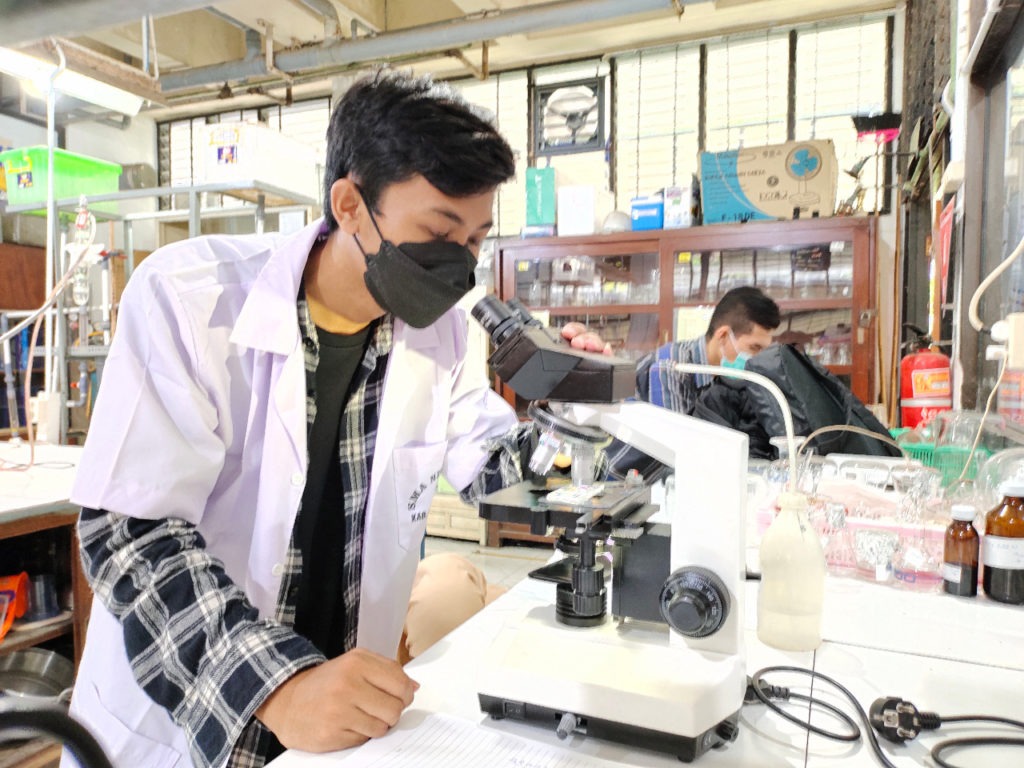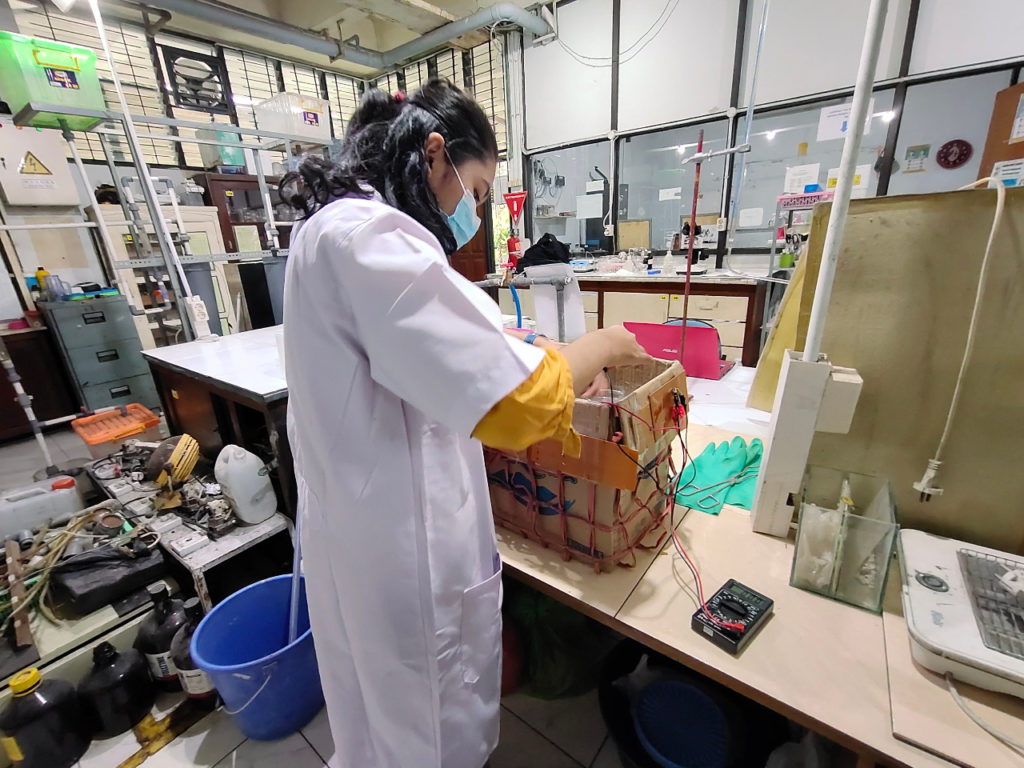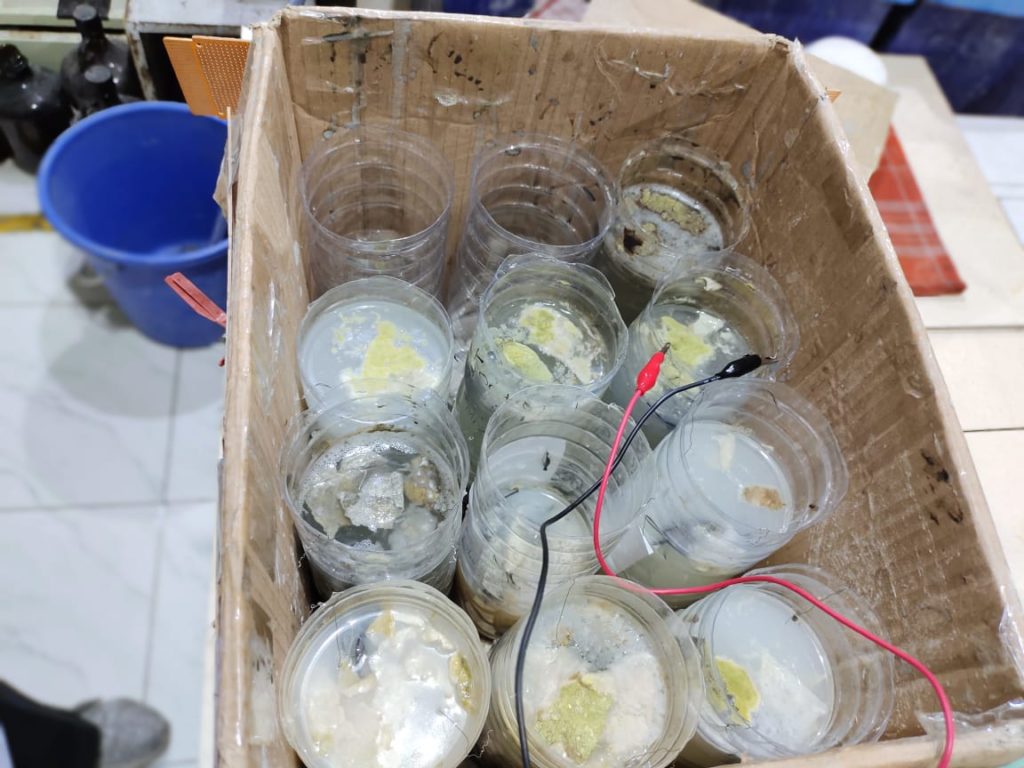ITS Students Innovate Electrical Energy from Straw and Mud Waste

The team’s research was carried out at the Industrial Waste and Biomass Treatment Laboratory of the ITS Chemical Engineering Department.
ITS Campus, ITS News – Until now, rice straw and mudflow from Sidoarjo are still seen as something that causes environmental problems, even though they both contain beneficial bacteria. Seeing these problems, Institut Teknologi Sepuluh Nopember (ITS) students innovated electrical energy from Sidoarjo straw and mud waste, which is currently not being used optimally.
As an agricultural country, Indonesia has an extensive area of rice farming land, so the rice straw waste produced is also very abundant. The straw waste contains relatively high cellulose and can be reused, but in Indonesia, its utilization has not been maximized. “This cellulose content can be processed into environmentally friendly electrical energy to replace fossil fuel electricity,” explained Qurratul Ain Farahiyah, team leader.

Calculation of electric current in the processed waste using a voltmeter
In her research, the girl called Fara explained that straw waste is used as a carbon source in the Microbial Fuel Cell (MFC) process. Namely, the method used to convert chemical energy into electrical energy through microbial metabolism of a medium as a catalyst. “This method transfers electrons from the anode through a copper wire, then generates an electric current to the cathode,” explained the ITS Chemical Engineering Department student.
More profoundly, Fara explained the process of processing rice straw and Sidoarjo mud into electrical energy. The extraction of straw waste precedes it; then, it is diluted and separated between the liquid and solid. This cellulose liquid is then taken for hydrolysis by a type of fungus called Aspergillus Niger to produce glucose. “One kilogram of straw waste can produce 11,362 grams per liter of glucose,” said the girl from Tenggarong.

MFC research on rice straw waste that has been mixed with bacteria and microorganisms
Glucose is then mixed with Sidoarjo mud to be fed as food for Shewanella Oneidensis MR-1 bacteria in the electrodes to produce electrons. Furthermore, electrons are transmitted from the anode to the cathode, both made of carbon cloth twill through a resistor conductor. “The Sidoarjo mud, which is often considered a problem, contains microorganisms that play an important role in the electron transfer process in the MFC,” said the 2021 student.
Fara added the more glucose used, the greater the electric current generated. This happens because the metabolism of bacteria in a solution with more glucose will be faster, and the rapid growth of bacteria will create a more significant amount of current. “The power of 8,515,351 milliwatts can be generated from processing 11,362 grams of glucose,” continued the girl who was born in May 2003.

(from left) Akbar Krisna Wandana, Dwi Mayasari, Qurratul Ain Farahiyah, Cherish Global Ethnic, and Ramadhita Putra Purnomo
With the guidance of Dr. Eng Raden Darmawan ST MT, this innovation has won a bronze medal in the Energy category at the Indonesia International Applied Science Project Olympiad (I2ASPO) competition organized by the Indonesian Young Scientist Association (IYSA) some time ago.
Fara and his four colleagues, namely Akbar Krisna Wandana (Department of Instrumentation Engineering), Cherish Global Ethnic (Department of Chemical Engineering), Dwi Mayasari (Department of Chemical Engineering), and Ramadhita Putra Purnomo (Department of Chemical Engineering), hope that this innovation can be investigated further with variables more varied experiments. “Hopefully, this product can be implemented as a real product to overcome the problem of waste and environmentally friendly electrification in Indonesia,” she hoped. (ITS Public Relation/far)
Reporter: Frecia Elrivia Mardianto
Related News
-
Facilitating Creativity of Students, ITS Information Systems Department Presents CCWS
ITS Department of Information Systems students conduct a discussion in one of the available spaces in the ITS Digital
February 04, 2022 09:02 -
ITS Explores Electrification Cooperation with PT Vale Indonesia
ITS Campus, ITS News — Following up on the Memorandum of Understanding (MoU) with PT Vale Indonesia, Institut Teknologi
February 04, 2022 09:02 -
ITS Reaches Top 7 BRIN Collaborators with 309 Scientific Publications
ITS Campus, ITS News — Institut Teknologi Sepuluh Nopember (ITS) continues demonstrating its commitment to strengthening collaboration in research
February 04, 2022 09:02 -
The Only One from Indonesia, ITS Student Becomes Erasmus+ Scholarship Awardee
ITS Campus, ITS News — Civitas academica of Institut Teknologi Sepuluh Nopember (ITS) has once again contributed to making
February 04, 2022 09:02
